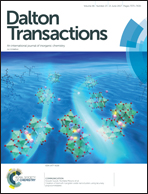Two unusual 3D honeycomb networks based on Wells–Dawson arsenomolybdates with d10 transition-metal-pyrazole connectors†
Abstract
Herein, two Wells –Dawson-type arsenomolybdates, formulated as [Cu(pyr)2]6[As2Mo18O62] (1) and [Ag(pyr)2]6[As2Mo18O62] (2) (pyr = pyrazole), were hydrothermally synthesized and structurally characterized via single-crystal X-ray diffraction, elemental analysis, IR and UV-vis-NIR spectroscopies, XPS, XRD, and TG analysis. The structural analysis indicated that compounds 1 and 2 were isomorphic. They are the first reported 3D honeycomb structures of Wells–Dawson-type arsenomolybdates. The [M(pyr)2] (M = Cu and Ag) connected with [As2Mo18O62]6− polyoxoanions to form the {812·123}{8}3 topological structure. The contributions of organic ligands, pH value, reaction temperature, and transition-metal (TM) to the construction of 3D networks were elucidated. Furthermore, compounds 1 and 2 exhibited fluorescence properties in the solid state at room temperature, highly efficient catalytic ability for the degradation of five organic dyes (MB, RhB, MO, AP, and CR) under UV irradiation, and obvious electrocatalytic activities for the reduction of H2O2. The mechanisms of photocatalysis and electrocatalysis have also been discussed in detail.



 Please wait while we load your content...
Please wait while we load your content...